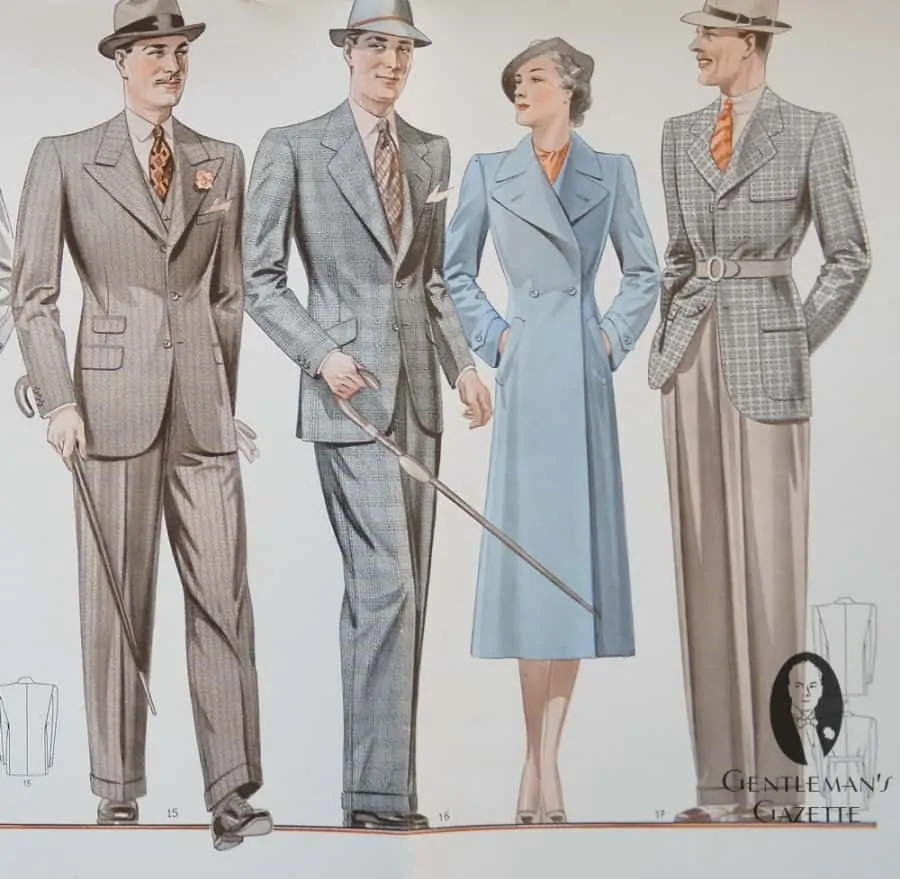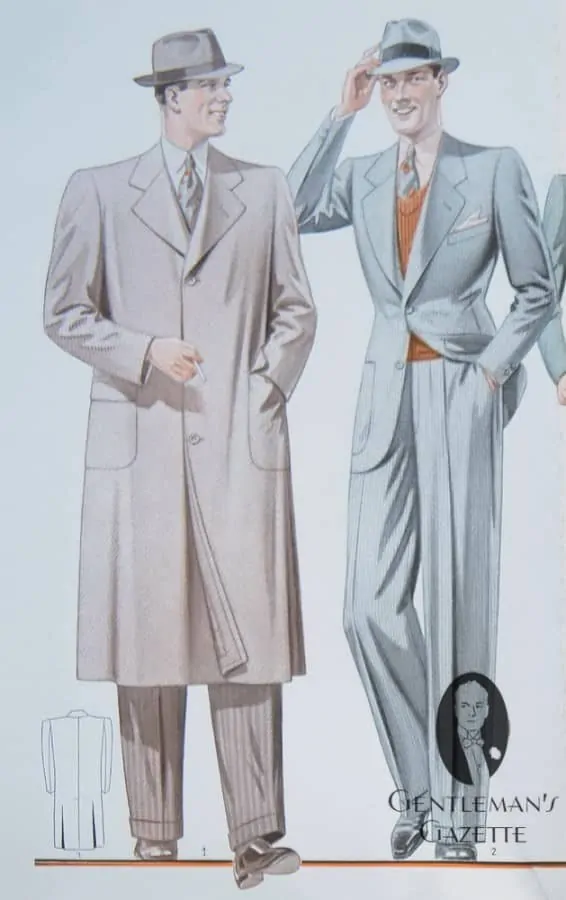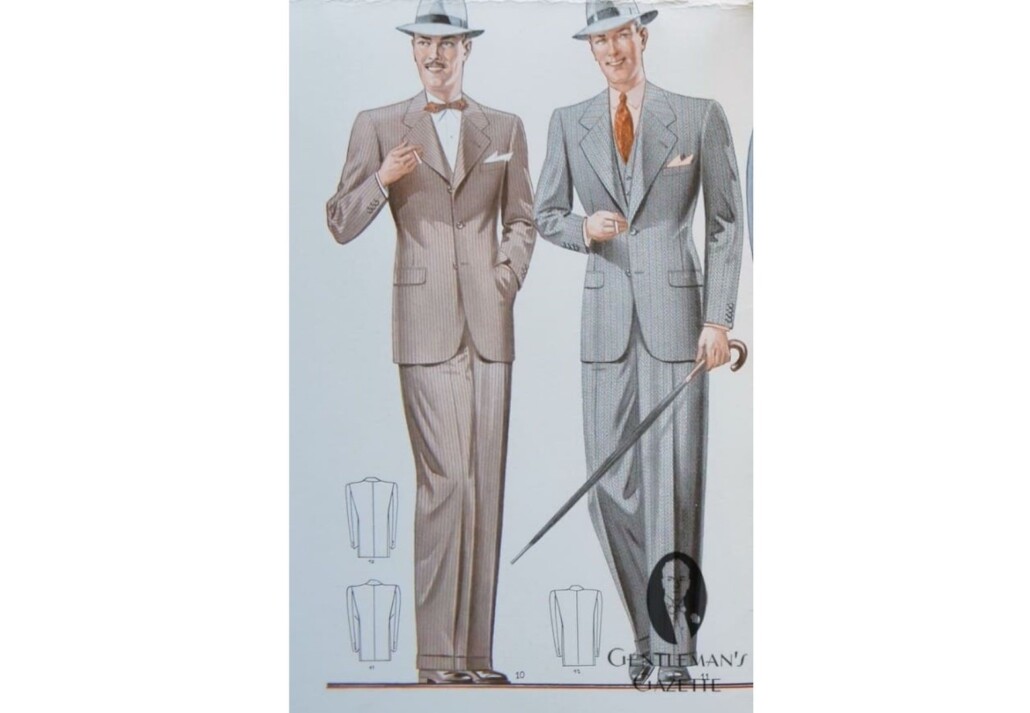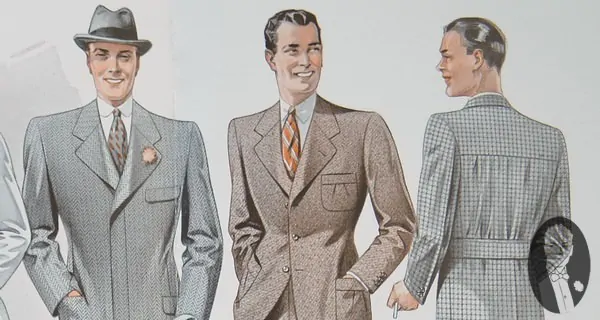Before I visited bespoke tailor Ruth Sprenger in Vienna, I also had the chance to inspect a number of vintage garments from Viennese bespoke tailors. These items dated back as far as the 1890s all the way to the 1980s. Among them were suits, tailcoats, morning coats, Trachten coats, shirts… from Konsul, C.M. Frank (now Knize) and various other local tailors.

Personally, I found that rather exciting because in the US, British, Italian and – to a limited degree – French and Spanish artisans are talked about much more, while other European countries are mostly ignored. Vienna, with its kings, emperors and musicians, used to have a great tailoring tradition, and to this day, there are a number of tailors, shoemakers, and chandelier makers, pastry makers etc., left.
Today, I want to discuss the Viennese tailoring style with a particular focus on the 1930’s.
Most of these vintage garments I saw – especially the ones from 1950 onwards – had one thing in common: their natural silhouette. By that, I mean only a slightly or unpadded shoulder with a very natural line, a tiny bit of drape over the chest and blades, a lower gorge and notched lapels, with the closing button being positioned within half an inch off the natural waistline.
Interestingly, the garments from the 1930’s reminded me very much of the English suits at the time, with a good amount of waist suppression, wider shoulders and full cut trousers. Obviously, London – or really, Savile Row – set the tone in men’s tailoring and changes in fashion back then were limited to little details: half an inch at the lapel width or back length were common. In the summer, the coats were shorter and the position of the buttons and pockets changed only marginally.
After I had seen the garments, I discovered an assortment of vintage local tailoring publications. In the beginning, I thought the 1938 edition of “English Fashion” was from England since it was printed in English. However, upon closer inspection, I realized it was actually written and published in Austria!

Now, of course the fashion was influenced by the British, though often British style, the way the Italians or Austrians perceive it, is not 100% in line with what the English actually wear.
Changes in Men’s Wear
In 1938, the changes were modest, but pre-WWII men’s clothing probably peaked in terms of elegance, in m y opinion. By then, the lounge suit had triumphed, and coats gain a bit of length in the back and featured a slightly lower buttoning point. The lapels were cut so they looked debonair and pointy without a lot of belly. Side pockets were aligned with the bottom row of buttons, the shoulders were moderately wide and slightly rounded.
In comparison, American fashion illustrations from the same year – which were also heavily influenced by Britain – are probably a bit more extreme in their proportions: more padding and wider shoulders, bigger lapels, more drape, etc.
Also, take a look at the German style from 1938.
The Viennese sleeves were wide at the top and more tapered towards the cuff. In regard to the “correct” sleeve length to visible cuff, 2cm (⅘ inch) showing was considered fashionable at the time. Also, double breasted, contrasting waistcoats were paired with suits – just think of a single breasted navy blue suit with dove grey vest: simply superb.

In regard to trousers, it was noted that they are still cut “wide enough”, which – compared to modern trends – was pretty wide. Interestingly, it is mentioned that only trousers worn with single breasted coats feature cuffs. Traditionally, cuffs were less formal and while cuff-less trousers are still the norm for tuxedo and tailcoat, many men wear double breasted suit with cuffed trousers. Personally, I think both can look good depending on the fabric. With a very classic chalk- or pin stripe suit, I’d opt against cuffs, whereas plaid or windowpane fabrics are great for cuffs.
Fashion Illustrations
Once you take a closer look at the fashion illustrations here, you realize the shoulder line is all very similar with a bit of padding, wide lapels with low gorge, which makes them appear shorter, especially on a 3 button single breasted coat. The front quarters are fairly closed.
Overall, it was really interesting to see how the Viennese interpretations of the English style were more subtle than the American cuts at the time, although both used the same source.
Do you know more about the Viennese tailoring style or different tailoring traditions? Please don’t hesitate to share it with us, we are always interested to learn more!
Apart from that, do you prefer the Austrian style over the American interpretation of English style?
Men’s Fashion Illustration Guide

The grey herringbone-suit on the picture above for instance is outstanding. Although I would have skipped the flap pocket at the breast to put in a pocket square the idea of a hidden placket on a suit jacket seems quite ahead of it’s time.
I also like the brown pin-stripe-suit withe peaked lapels at the second picture.
Again, the gentleman’s gazette has proven why it stands out in it’s kind. Thanks a lot for sharing these inspirational illustrations.
Isn’t the grey herringbone, with fly-covered buttons, an overcoat, rather than a suit (as the previous poster suggests)? It looks that way to me, but cuts off the bottom half of the picture so I can’t be sure.
Interesting pictures. I can’t see much drape in the suit cut at all – minimal at most. But that means that the suits are actually much closer in their cut to the sort of only slightly draped, natural line, suit jackets we tend to have today.
I rather like the light brown herringbone/shadow striped peaked lapel number in the second illustration.
Are there good examples of the contrasting waistcoat look you mention?
Dear Hal,
now that you say it, it is really possible, it is rather an overcoat. The sleeve-length seems too long for a coat. Thanks for mentioning it.
One minor correction – CM Frank is now NIEDERSUESZ (the spin-off from Knize). Apparently the owner allowed his son the use of the illustrious CM Frank name to assist his new enterprise.
It is very interesting to note the variation in tailoring styles in different countries. The illustrations above feature wonderful suits and topcoats.